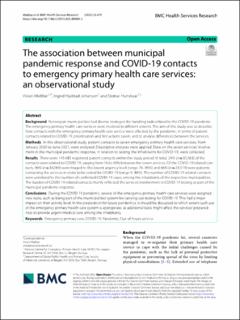| dc.contributor.author | Midtbø, Vivian | |
| dc.contributor.author | Johansen, Ingrid Hjulstad | |
| dc.contributor.author | Hunskår, Steinar | |
| dc.date.accessioned | 2023-10-20T07:53:38Z | |
| dc.date.available | 2023-10-20T07:53:38Z | |
| dc.date.created | 2023-05-19T10:46:01Z | |
| dc.date.issued | 2023 | |
| dc.identifier.citation | BMC Health Services Research. 2023, 23 (1), . | en_US |
| dc.identifier.issn | 1472-6963 | |
| dc.identifier.uri | https://hdl.handle.net/11250/3097719 | |
| dc.description.abstract | Background Norwegian municipalities had diverse strategies for handling tasks related to the COVID-19 pandemic. The emergency primary health care services were involved to different extents. The aim of this study was to describe how contacts with the emergency primary health care service were affected by the pandemic, in terms of patient contacts related to COVID-19, prioritisation and first actions taken, and to analyse differences between the services. Methods In this observational study, patient contacts to seven emergency primary health care services, from January 2020 to June 2021, were analysed. Descriptive analyses were applied. Data on the seven services’ involvement in the municipal pandemic response, in relation to testing the inhabitants for COVID-19, were collected. Results There were 145 685 registered patient contacts within the study period. In total, 24% (n = 35,563) of the contacts were related to COVID-19, varying from 16 to 40% between the seven services. Of the COVID-19 related contacts, 96% (n = 34,069) were triaged to the lowest urgency level (range 76–99%) and 66% (n = 23,519) were patients contacting the services in order to be tested for COVID-19 (range 5–88%). The number of COVID-19 related contacts were unrelated to the number of confirmed COVID-19 cases among the inhabitants of the respective municipalities. The burden of COVID-19-related contacts mainly reflected the services’ involvement in COVID-19 testing as part of the municipal pandemic response. Conclusions During the COVID-19 pandemic, several of the emergency primary health care services were assigned new tasks, such as being part of the municipalities’ system for carrying out testing for COVID-19. This had a major impact on their activity level. In the preparation for future pandemics, it should be discussed to which extent such use of the emergency primary health care system is appropriate, as additional tasks might affect the services’ preparedness to provide urgent medical care among the inhabitants. | en_US |
| dc.language.iso | eng | en_US |
| dc.rights | Navngivelse 4.0 Internasjonal | * |
| dc.rights.uri | http://creativecommons.org/licenses/by/4.0/deed.no | * |
| dc.title | The association between municipal pandemic response and COVID‑19 contacts to emergency primary health care services: an observational study | en_US |
| dc.title.alternative | The association between municipal pandemic response and COVID‑19 contacts to emergency primary health care services: an observational study | en_US |
| dc.type | Peer reviewed | en_US |
| dc.type | Journal article | en_US |
| dc.rights.holder | © The Author(s) 2023 | en_US |
| dc.description.version | publishedVersion | en_US |
| cristin.ispublished | true | |
| cristin.fulltext | original | |
| cristin.qualitycode | 2 | |
| dc.identifier.doi | 10.1186/s12913-023-09489-2 | |
| dc.identifier.cristin | 2148073 | |
| dc.source.journal | BMC Health Services Research | en_US |
| dc.source.volume | 23 | en_US |
| dc.source.issue | 1 | en_US |
| dc.source.pagenumber | 9 | en_US |

